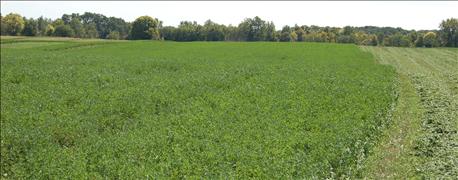February 11, 2016

When I see broomsage growing in a pasture or hay field, I suspect soil fertility is low. The soil may also be acidic. Here are five ways to improve pastures and hay fields. All five ways relate to soil testing and soil fertility, particularly to correcting acidic soils low in pH.
1. Refer to recent soil test results or sample soils now
You’re less likely to have current soil test results for pasture or hay fields. If the field hasn’t been tested for several years, pull soil samples now. It’s critical to know soil pH levels, and also levels of phosphorus and potassium.

ITS ABOUT pH: Excellent stands require correct pH, soil fertility- The pH for this field of alfalfa hay was adjusted through liming before alfalfa was established.
If you pull samples yourself, either sample by soil type or on grids, usually 2.5 acres or smaller. A smaller sampling size helps pinpoint pH levels more accurately. Pull several cores, allow soil to dry, and send a composite sample to a soil testing lab.
2. Pay attention to pH level reported in the test.
If the pH level is less than 6.5 and you want to raise alfalfa, you need to correct it. If you’re raising clovers you can likely obtain reasonable results if the pH is 6.0 or higher. When pH levels are under 6.0, plan for lime applications.
3. Pay attention to the cation exchange capacity reported on the soil test sheet.
For CECs in the 9 to 12 range, which could be common on lighter soils, it doesn’t take as much lime to produce a change as on higher CEC soils. Dark, productive soils which are low in pH will require higher rates of lime to change the pH. Remember that pH values are not linear- in other words, a pH of 5.0 is 10 times more acidic than a pH of 6.0, and a pH of 5.0 is 100 times more acidic than a neutral pH of 7.0.
4. Lime is needed to correct acidity created by nitrogen fertilizer
Generally speaking, it takes four pounds of lime to correct the acidity created by applying one pound of nitrogen fertilizer. As ammonium molecules convert to nitrate molecules, a form of nitrogen plants use, hydrogen ions are released, creating acidity. This acidity needs to be neutralized to raise soil pH.
5. Where very high rates of lime are recommended, you may split applications and apply at different times.
This is especially true if the soil has a lower CEC value. You can apply lime on the surface if the pH is very low and needs to be corrected right away. It will take longer to realize the full value of the lime, but it will begin to work soon. An ideal time to apply lime is while renovating a pasture or preparing to seed a new hayfield, and tillage is involved. Tillage provides mixing of the soil.
- Parker is a retired Purdue University Extension educator, and cattle and hay producer. He writes the Forage Notes column in Indiana Prairie Farmer.
You May Also Like




